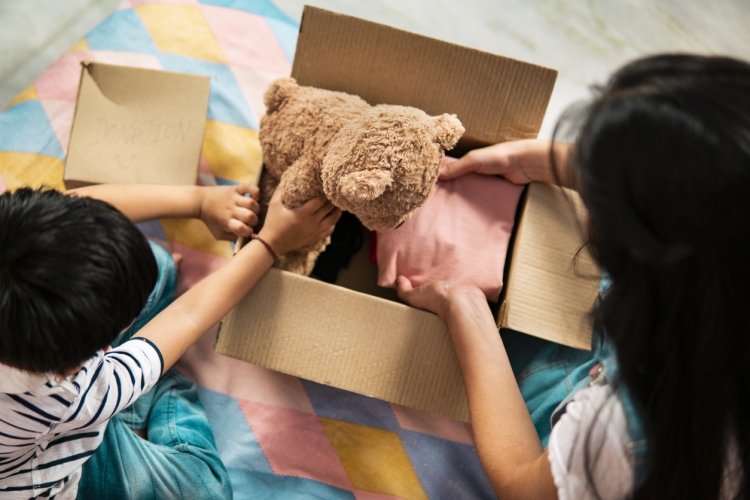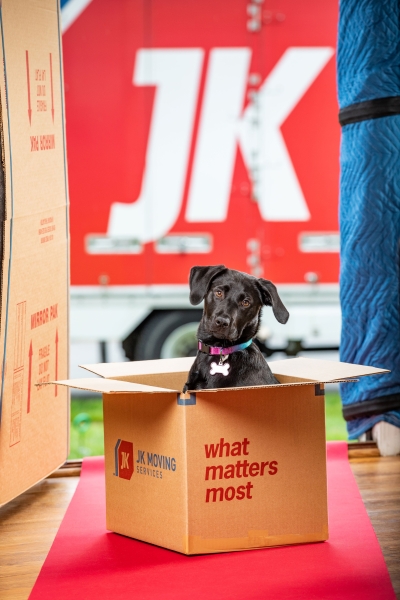Moving can be a complex process, especially when relocating with family members.
Moving doesn’t have to be stressful. Our complete family moving checklist outlines all the tips and tricks you need to make your transition as smooth and seamless as possible.
1. Moving preparation for families
Use these tips to help you start preparing your family for the big day.
Discuss a moving date
Moving with kids is often tricky, and you might find the process even trickier if you don’t take your children’s opinions into consideration when deciding on the moving date. This is especially important for parents of school-age children like tweens, teenagers, and young adults who may have more emotional stakes in a family relocation than younger children.
Set aside time before the move to discuss the best possible time frame with each of your children. Not only does this conversation open the floor for them to talk openly about how moving makes them feel, but it also allows them to feel like they are a part of the decision. Most kids will probably choose to move at the end of a school year to make the transition easier on them, but listen to their points either way and try to compromise with them if possible.
Create a moving budget
Moving is a resource-heavy endeavor in terms of both time and money. Lay out a budget in the earliest stages of your move that will account for the moving crew, moving day expenses, packing materials, and an emergency fund for unforeseen occurrences. If you are unsure how much materials and services will cost, you can request quotes from various moving companies in advance to get an idea of how much you will be spending.
Hire a moving company
Parents already have their hands full keeping both kids and pets safe and comfortable throughout the move. Hiring a moving crew eliminates extra stress from moving day activities by allowing parents to focus their attention on managing the family rather than actually transporting items.
Do your research beforehand to find a moving company that suits your needs, fits your budget, and has availability during your required time frame. Read reviews of companies online and obtain quotes from multiple services to help narrow down the decision.
2. Decluttering and downsizing
The key to truly stress-free moving is to downsize your belongings to a manageable amount. Include these decluttering strategies in your family moving checklist.
Assess your belongings

The first step in the packing process is figuring out which items you will keep, donate, sell, or discard. Every family has their own strategy to tackle this somewhat daunting task, but one effective way to go about it is to move from room to room, focusing only on the items within each room at a given time. Use color-coded sticky notes and labels to mark items according to their destination.
Go through your children’s belongings with them and help them come to decisions about what to keep. Use sticky notes, stickers, or another fun sorting system to keep them interested and motivate them to continue. Start early enough that you can take breaks and tackle different sections of your family belongings slowly.
Organize a sale
Once you have determined which items you want to leave behind, consider organizing a garage sale or posting the items for sale online. You may find that the extra funds will help with the cost of your moving day expenses.
You can also arrange to donate items to a local charity or ask your moving partner if they have a recycling program for larger items. Be sure to check local guidelines when throwing any items away to make sure they are properly and safely discarded.
3. Home transition planning
Don’t forget to bring these family moving essentials along to your new location.
Gather important documents
We recommend creating a moving binder that will hold all your valuable documents safely in one place throughout the move. Examples of important documents include passports, birth certificates, Social Security cards, work permits, medical records, vehicle documentation, financial statements, marriage certificates, insurance documents, and more. You should also keep any relevant moving paperwork handy.
Do not pack your moving binder with other items. Keep it with you on moving day and transport it yourself to make sure it remains safe.
Transfer records and utilities
Be sure to transfer all essential home utilities prior to moving day, including gas, electricity, water, phone, Wi-Fi, and TV provider. Also contact your current utility providers to set up a date to disconnect them from the home you’re leaving.
Remember to change your address and cancel or transfer all delivery or subscription services as well. You can change your address with the USPS either in person, on the phone, by mail, or online. You will also need to transfer medical, dental, and school records to your new doctor, dentist, and school district before leaving.
4. Packing for a family move
No household moving guide would be complete without detailing the supplies and essentials needed for an easy transition.
Get the right supplies
Depending on the types of items you will be bringing along to your new home, you will need a variety of packing supplies to keep them safe. Boxes are a given, and you can sometimes be found for free through your mover. You can find them at hardware stores as well.
Stock up on bubble wrap, newspaper, and tape for wrapping fragile items. If you need to move any furniture around yourself, you can use sliders to make it easier or disassemble the furniture. Pay attention as you disassemble the pieces though to make sure you remember how to reassemble them at your new home.
Pack essentials for your kids and pets
 Set aside important items for children and pets that they will need on moving day. Your kids’ box may consist of items like toys, snacks, diapers, electronics, books, or stuffed animals. A pet’s box should include food, toys, bedding, blankets, water, and treats.
Set aside important items for children and pets that they will need on moving day. Your kids’ box may consist of items like toys, snacks, diapers, electronics, books, or stuffed animals. A pet’s box should include food, toys, bedding, blankets, water, and treats.
You know your family the best, so bring essential items that will help them stay relaxed, entertained, and stress-free throughout the transition.
5. Moving day organization
Ready for the big day? Add these tips to your family moving checklist!
Make a plan for moving day
Make the moving day fun, but safe, for your children. If you have relatives or friends close by who can help, it might be best to have your kids spend the day with them, doing fun some activities. Or set up a play date for find a babysitter. Keeping them from being underfoot while the movers are working in your home is a top priority for their safety and the safety of the moving crew.
Do a final walkthrough
Do one last check of your old property to ensure that all windows and doors are secured, all utilities are shut off, and you didn’t leave anything behind. This last walkthrough should help put your mind at ease before you set off for your destination.
Communicate with the moving crew
Make sure the moving crew is aware of any special instructions for handling items. It may help to briefly show them around as well, but otherwise you can greet them and then let them get started. If you’re moving during hot weather, try to provide some snacks and drinks as well.
Dress appropriately
Wear loose, comfortable clothes that you won’t mind messing up with dust, dirt, sweat, etc. You should also sport some closed-toe shoes that have a decent grip, especially if you plan on helping out with the actual moving process. Check that your children dress safely too.
6. Settling into your new home
Let’s wrap up our family moving checklist with a few strategies to help you settle into your new home.
Get the lay of the land
When you arrive, you can give your kids a full tour of your new home to get them excited about moving in. Show them hidden doors or staircases and allow them to explore, as long as they are out of the way of the movers.
After the tour, if you have limited access to a babysitter or play date, create a familiar space in your young children’s new bedrooms. Make their beds, hang their curtains, and pull out their favorite toys, books, and blankets.
Explore the new area
As you settle into your new home, set aside time to explore the new area with your family. Kids may feel more at ease checking out a new place with a parent present. Point out landmarks and exciting places to visit. Make sure that they are also aware of their new boundaries, whether they need to stay in the yard or the neighborhood.
Establish routines
Try to re-establish family routines as early as possible. The familiarity of having dinner and bedtime routines take place at the same time as usual can help all members of the family feel more at home in the new location, easing the stress that comes with such a big transition.
Create familiar spaces
Don’t procrastinate unpacking! Use your household items and furniture to set up familiar spaces for children that will quickly start to feel like home. This strategy can also be effective for helping pets become accustomed to their new environment.
The key to a successful and stress-free family move lies in careful planning and consideration. Establishing a detailed family moving checklist, involving your children in the process, and maintaining a well-thought-out moving day strategy will contribute to a smoother transition. By following these steps, you can help ensure a more organized and less stressful moving experience for everyone involved.


